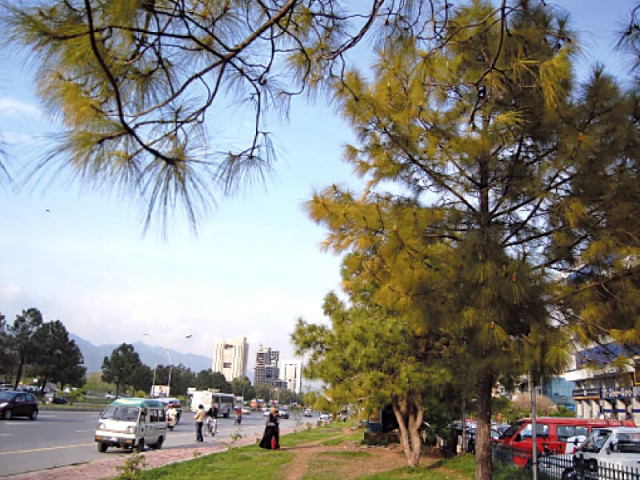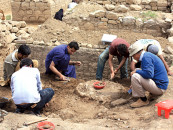Relocation for metro bus: For many trees, second chance may just be delayed death
CDA identifies 1,692 trees for relocation, environmentalist questions ability, cost estimates.

CDA identifies 1,692 trees for relocation, environmentalist questions ability, cost estimates. PHOTO: MUHAMMAD JAVAID/EXPRESS
As many as 1,692 plants and trees of two-to-30 inches diameter falling within the approved route alignment of Islamabad’s section of the metro bus project will have to be moved.
This was listed in a recent Capital Development Authority (CDA) Environment Wing survey, a copy of which was obtained by The Express Tribune. The survey also states that 340,000 square feet of developed green areas along 9th Avenue and Jinnah Avenue will also be dug up to pave way for the route.
To cover the cost of relocation, the environment wing has put forward an estimate of Rs7.97 million in its survey. The relocation cost of each tree is calculated on the basis of its size.
The survey says it will be as low as Rs 425 for a two-inch diameter Bougainvillea, and as high as Rs25,000 for a 16-inch Chir Pine.
“The site where these trees will be relocated is still undecided, but it will be close to the place from where they are currently located,” said a senior official of the environment wing.
The official said that soon the Rawalpindi Development Authority — the executing agency for project — will be asked to release the estimated funds as early as possible to ensure early relocation of these trees.
He said the amount will be paid out of the one per cent of total cost of the Islamabad section of the project already earmarked for the preservation of environment and horticulture of Islamabad.
Some 732 Gaub trees, 445 Bougainvilleas, and 350 Cassia, amaltas and crepe myrtles located between Peshawar Mor and PTCL Chowk would be relocated under the proposal.

Similarly, 14 shisham, mango and eucalyptuses ranging between nine and 30 inches diameter would also be relocated at a cost of Rs8,000 per tree. Some 38 chir pines between eight and 16 inches wide will cost Rs25,000 per tree to move.
While, 78 jacarandas, ajar, silver oaks, celtis, eucalyptus, and banyans would be relocated at Rs8,000 per tree. These 78 trees are between five and 26 inches wide.
It’s worth remembering that tendering for the project has already been completed, and the RDA is expected to issue work orders to successful contractors on April 17.
This is despite the fact that the Pakistan Environmental Protection Agency has yet to approve the environmental impact report for the project. A public hearing on the project and its environmental impact is scheduled on May 3.

“It has clearly been mentioned in the EIA report prepared by the design consultant, NESPAK, that the project could not be initiated until environmental clearance is given,” said an official.
An eyewash?
n the other hand, environmentalist Dr Jawad Chisti termed the CDA’s claims about relocation of years old trees an eyewash. He questioned the available expertise and resources required for this purpose.
“We don’t have a single example of successful relocation of certain trees in Islamabad,” Chisti said adding that the trees which were relocated from the site of the Zero Point Interchange during its construction dried up within days of their shifting.
He said that according to international standards, Rs1.2 million would be required to successfully shift a single large tree, besides the expertise and technology involved in the process. All these trees are wild, and the rate of survival in case of relocation of such trees is near zero, Chisti said. The chances of survival also reduce for trees older than 20 years, irrespective of technology and expertise.
He also questioned the survey itself, saying that in Pakistan, only the Peshawar University forest department has the expertise to carry out such surveys.
Published in The Express Tribune, April 15th, 2014.


















COMMENTS
Comments are moderated and generally will be posted if they are on-topic and not abusive.
For more information, please see our Comments FAQ